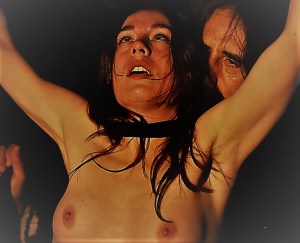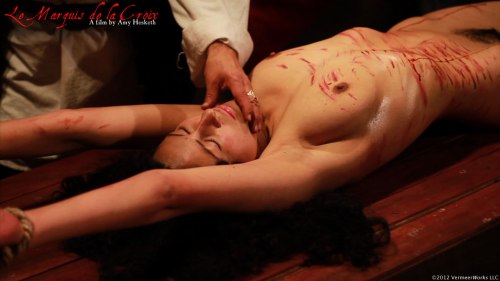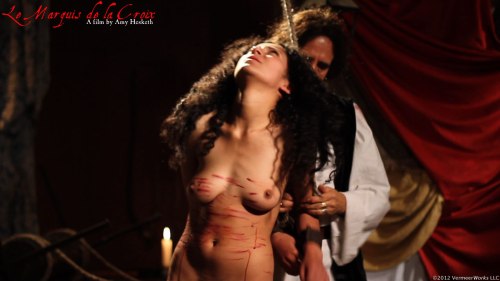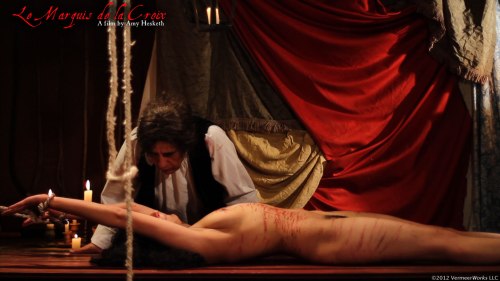by Rich Moreland, April 2017
In this third post we’re going to take a look at the “arc” of Le Marquis de la Croix.
Jac Avila’s and Amy Hesketh’s remarks come from the commentary section of the DVD. I’ve used their thoughts to build my analysis of film.
As always, I encourage everyone to watch Le Marquis and interpret the story for themselves. To check out trailers from the film, click here.
All photos are courtesy of Pachamama Films.
* * *
Personal Catharsis
Amy Hesketh gives us a snapshot of the type of characters she and Mila Joya play in Pachamama productions.
Roles like Zynga are “special” for a woman, the director of Le Marquis declares, because they become a “personal catharsis.” In other words, an actress encounters experiences beyond her present reality and the range of emotions that accompany them.
Amy mentions death as an example.
The director also believes that films like Le Marquis concentrate on image making as a statement of art. The tortured woman becomes poetic especially when portrayed by the talented Mila Joya. She expresses so much without words, Jac Avila interjects, using her eyes to communicate pleading, pain, and resignation.
Intimacy
There is another character in Le Marquis: the setting. It dictates the narrative, emerging as a force that brings out the pain suffered by both victim and torturer. Other Pachamama films like Maleficarum and Justine also do this well.
The dungeon is a state of anima/animus and yin/yang, Amy believes, opposites that are psychological constructs of the self. In other words, the torturer and his victim develop a personal intimacy within the confines of the chamber.
“There’s something that happens in this whole arc . . . the characters are together” in their state of mind, she says.
Their intimacy emerges. Zynga often gazes at the marquis with abject servility, offering herself to him while he worships her as the object that gratifies his sadism.
Do they have real affection for each other? Perhaps.
At any rate, the tension between denial and survival further defines the arc of Le Marquis.
To put it another way, Zynga’s needs are physical and immediate; the marquis’ are psychological and emotional. Both are sides of human existence that combine to form a whole person severely circumscribed within the miserable confines of the prison.
Consider this, the torture scenes reinforce one kind of denial when Zynga begs for the wine so she can physically survive; whereas, another version of denial, this time psychological, is overcome when the aristocrat gives in to his need to increase the intensity of the tortures.
In Le Marquis survival is at stake in the power play between the dominant and submissive. As Amy puts it, the desperate gypsy makes a deal to be sold rather than being executed only to discover her choice will lead to her doom.
That, I think, is the “arc” that Amy creates with her performances and directing, not only in Le Marquis but other films as well.
An Intimate Position
The image of Zynga in chains is a device of suffering, Amy asserts, but it’s also erotic. The marquis’ control over her and her reaction to the tortures are part of the carnal appeal of the film.
In truth, it’s the psychological essence of sadomasochist sexuality.
Accepting that vision, Amy comments on the rack scene. It offers a different feel from whipping because the victim is lying down which injects a sensual component into the scene.
She references the rack as “an intimate position like someone sitting on the side of the bed and talking to you.” This scenario creates “an emotional and physical dialogue” between torturer and victim.
We see it in Ollala, for example.
How easy is it then for the marquis and Zynga to take the next step and become lovers? After all, the victim is open to penetration were that a choice the torturer decides to make.
In Sade’s writing, that line is crossed frequently, but only suggested in Le Marquis . . . or at least we suppose.
A Violent Act
Amy Hesketh emphasizes the rack’s sadomasochitic implications by underscoring sex as a violent/aggressive act often witnessed in animal mating behavior. For Sade, torture is part of a sex act that exists within in the mind, she believes.
This is in play when the marquis touches Zynga lovingly, then releases the tension only to begin the process again. On a metaphorical level each pull of the ropes is a moment of ecstasy for both the masochist and the sadist . . . an orgasm, so to speak.
Later in the preparing for Zynga’s crucifixion, the nobleman runs the tip of the nail over her cheek and body in a gesture of admiration and sacred adoration.
The emotional intensity is breathtaking.
Of course, the nails will penetrate Zynga’s body in an intimate act much like Dracula’s blood sucking when his phallic-like fangs puncture the flesh.
So how far can we go in equating sex, the act of procreation, with the end of life? I suspect Amy is telling us it is part of the “arc.”
 It’s worth mentioning that hints of sex and torture as interchangeable parts subtly pervade films like Justine, Dead But Dreaming (consider the vampire roles of Jac Avila and Mila Joya) and Barbazul (the erotic writer, Jane, is whipped and strangled when she resists Bluebeard’s offer to sexually “play”).
It’s worth mentioning that hints of sex and torture as interchangeable parts subtly pervade films like Justine, Dead But Dreaming (consider the vampire roles of Jac Avila and Mila Joya) and Barbazul (the erotic writer, Jane, is whipped and strangled when she resists Bluebeard’s offer to sexually “play”).
But Le Marquis presents a twist. The gypsy’s sexual presence is so overwhelming that she emotionally emasculates her torturer in the best moments of denial in any Pachamama Film to date.
How do we know? Study the marquis at his desk writing and sipping wine while Zynga suffers behind him. His manner defines what it means to be clinical, distant, and devoid of overt emotion before modern psychology studied such things. Simply put, he has repressed his need to “feel” in order to sate his deviancy.
Frozen in Time
Amy Hesketh comments that the Marquis de Sade lived in his mind. His psychological self and his world were well-developed because neither extended beyond the walls of his prison.
In Le Marquis, Amy puts this observation into play. When Zynga becomes part of her torturer’s limited universe, he introduces her to severe acts of misery then follows the gypsy’s agonizing rhythms as her suffering intensifies.
It is the motion of the sexual, waves of ecstasy crash and recede in the poetry of the human condition.
Her painful contortions devolve into images frozen in time when she loses consciousness.
Zynga’s crucifixion animates this point. Amy states that she wants to create visual representations much like “a painting from a book” when shooting such scenes. It’s another way of interpreting the “frozen moment.”
To “Feel” Something
Though Le Marquis is told through a progression of images depicting the gypsy’s gradual descent into the horrors of the abyss, Amy points out that audiences today are not shocked by physical depictions of blood and pain (modern slasher films probably contribute to an ennui that numbs all of us).
On the other hand, persuading people to “feel” something in that regard, to get them to take notice, so to speak, is new.
To do that, film must become a mirror, she implies.
“The only emotions you can show someone are their own,” Amy declares. The key is to find the triggers that engage the viewer.
Le Marquis reaches for that difficult goal.
Next the fourth post will look at the Zynga’s crucifixion as a statement of the sacred feminine.
* * *
For my review of the other Pachamama Films mentioned in this analysis, check the following: Dead But Dreaming (May 2016), Ollala (July 2016), Barbazul (September 2016), and Justine (December 2016).















